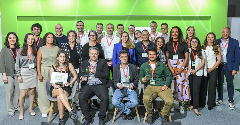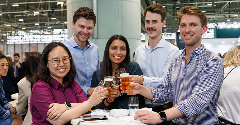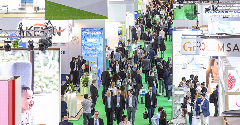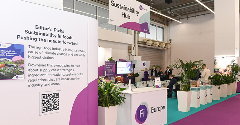News
Digital innovations and holistic health in the Chinese market
13 Jun 2023
Health and wellness consumers in China are much younger than in the West, according to industry experts who say a tendency to act preventatively rather than reactively, coupled with a digital-first culture, gives brands an opportunity to retain consumers for many more years throughout the lifespan.
And with more than 90% of the country’s consumers shopping via app, there are multiple opportunities for brands to engage with their audience via digital innovations such as virtual reality and live-streaming, says Zarina Kanji, head of business development and marketing for Tmall Global at Alibaba Group, UK and Nordics.

Merging past with present: A heritage of holistic health
China’s health and wellness industry was valued at $683 billion last year, making it the second-largest wellness market in the world after the US, according to statistics from the Global Wellness Institute. Meanwhile, the Chinese National Bureau of Statistics reports that annual online retail sales have nearly doubled in the last five years.
Supplements in the health and wellness market are considered to be of such importance, they are often referred to as “the fourth meal”. Meanwhile, the notion of combining Traditional Chinese Medicine with modern supplements is “very, very popular”, Kanji said.
“Chinese consumers… really do look at history as well as modern science to their approach to wellness,” she added. “And this, of course, affects their mind as well.”
Digital innovations can help brands to engage with consumers by making shopping for wellness fun, she said.
“Making shopping fun in the wellness world helps with the holistic element because you have a problem, you want to solve it, your health isn't good. But if you can make that experience of purchase enjoyable, then overall it impacts your entire journey to wellness,” she added.
Digital innovations bridge the gap between online and offline
Live-streaming is one of the most popular ways that consumers in China access products, said Kanji. This format bridges the gap between online and offline, giving brands the opportunity to talk at length about their product and recreating the experience of speaking with an in-store sales associate who can inform customers about clinical trials, ingredients, or dosage.
“It's a really engaging format to do business and also for the consumers,” said Kanji. “We like to call it shoppertainment. It's shopping and it's entertainment, all rolled into one.”
Another novel digital format for delivering product expertise is via an artificial intelligence key opinion leader. Kanji used the example of Ariel, a virtual avatar launched by Holland & Barrett for Alibaba Group’s 11/11 festival last year – Singles’ Day, China’s biggest shopping holiday. Ariel was used to deliver product expertise to international consumers, offering “a really exciting way that you're able to change up and excite the customer”.
Kanji also referenced the metaverse, using a Swedish brand called Miracle as an example; it took part in a Metaverse experience as part of Goddess Day, another Chinese shopping festival.
“As a consumer, you could enter the metaverse: you become an avatar yourself and you can journey through and explore the different products that are available,” she explained. “And with Miracle, they also had a collectible NFT – a digital token that the consumers could buy along with this particular supplement product.”
And she warned that brands looking to reach new audiences should not discount the participation of older generations in this digital-first culture. The tech-savvy Granny is a “very, very, very big market in China”, she said.
 © AdobeStock/tirachard
© AdobeStock/tirachard
Key consumer trends in the Chinese market
Kanji highlighted beauty-from-within as a staple subcategory that has “forever” been one of the top performers in China, due to the fact that a holistic approach is “deeply ingrained” in its history.
“Looking right back to the Confucius era, there are sketches of Chinese women who are looking at their wellness – looking at how they look, but also considering their inner wellness,” she said. “And those two things have really worked hand in hand – that holistic mindset to beauty has always existed.”
Another defining characteristic of the Chinese consumer is that they are highly educated when it comes to health and wellness, she said. She used the example of the fish oil market as one that was “really growing fast in China”, adding that consumers are “very, very careful” in looking into the quality of the ingredient.
“Which sea did it come from? How quickly has that fish been taken from sea to an oil and to the bottling and the capsules? It goes down to that research, that timing, that wanting to be very aware of what you're putting into your body that Chinese consumers hold in such high regard,” she said.
Probiotics, too, present a “really exciting” market: last year, they grew 70% year-on-year as a category. While women's health, beauty-from-within, and gut health are growth categories also reflected in other global markets, there are some quirks unique to the China. Kanji used the example of probiotics for nasal health, of interest due to the high levels of pollution in many big cities.
“Looking for products that will help probiotically impact your microbiome through the nasal capacity is a very interesting category in China,” she said.
Kanji added: “It's all about the whole body, the whole mind, and that's how the Chinese consumer is really, really evolutionary – and revolutionary – in their approach to holistic health.”
Related news

Walmart Marketplace’s record growth prompts search for UK sellers
26 Sep 2025
Walmart’s third-party e-commerce platform, Marketplace, has witnessed extraordinary growth – but a need for more product diversity has prompted the retailer to recruit UK sellers.
Read more
The winners of Vitafoods Europe Startup Challenge 2025 revealed
29 May 2025
Four startups – Yomio Drops, PFx Biotech, Revobiom, and Favamole – took top prizes at this year’s Vitafoods Europe Startup Challenge awards.
Read more
East takes on West in the fight for future food flavours
30 Apr 2025
Asian and South American flavours are now key components on global menus, driven by a growing global appetite for culinary mashups.
Read more
Food companies urged to bring ‘joy’ and urgency to healthy food mission
14 Mar 2025
For too long, businesses have treated health and sustainability as separate agendas – but there is growing evidence to show diets that benefit human health can also enhance that of the planet, say experts.
Read more
Entries open for inaugural Vitafoods Europe Innovation Awards
29 Jan 2025
Entries are open for the inaugural Vitafoods Europe Innovation Awards, celebrating the ingredients, finished products, partnerships, and initiatives redefining the nutraceutical landscape.
Read more
Paris Olympics: Food and beverage brands champion health, fun, and sustainability
5 Aug 2024
Food and beverage brands are aligning with the Paris Olympics 2024 Food Vision, which emphasises sustainability, local sourcing, and plant-based diets.
Read more
Natural Remedies: Bringing health and happiness via validated branded ingredients
18 Apr 2024
Natural Remedies is an internationally renowned botanical healthcare company committed to advancing the field through rigorous research and the development of clinically validated Branded Ingredients. Guided by our foundational principle of ‘BEING USEF...
Read more
Exploring the future of health and wellness retail at Vitafoods Europe
14 Mar 2024
With retail-focussed content sessions, buyer networking, and finished product tasting sessions, this year’s Vitafoods Europe offers a not-to-be-missed opportunity for retailers to up their health and wellness game.
Read more
Sustainability meets innovation at Fi Europe 2023's Sustainability Ingredients Zone
9 Jan 2024
Fi Europe’s Sustainable Ingredients Zone showcases ingredients forging a path toward a greener future. Three innovators are redefining what sustainability within the food and beverage industry means, with upcycled products, regenerative agriculture, an...
Read more
Unleashing the power of plants at Fi Europe’s New Product Zone
5 Jan 2024
In the diverse landscape of plant-based innovation, Fi Europe 2023's New Product Zone spotlighted ten plant-based ingredients, tailored to meet the rising demand for sustainable and delicious options.
Read more